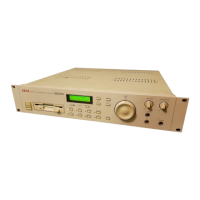SAMPLE EDIT
S2000 Operator’s Manual - Version 1.30 Page 149
NOTES ON USING FADE UP/DOWN
Sometimes, you may use TRIM to edit out the start or a sample but this can make the attack
rather hard and so setting a FADE UP can be useful for softening the attack of a sound in such
circumstances. Setting very short fades can be useful getting rid of clicks or other unwanted
noises at the start of a sample.
FADE DOWN can be best utilised on drums. Often, a drum sound may be noisy and the FADE
DOWN function can be a good way of masking this. Also, due to constraints in memory, you
may have to cut a long sample such as a cymbal short so as not to eat up too much of your
valuabel memory space. In this situation, applying a fade down to such sounds can be very
useful. There are two ways you can do this. You could set a FADE FROM value that matches
the start of the sample so that it will start fading as soon as the sound is triggered. This can give
a smooth result but does have the effect of shortening the sample. You may prefer, therefore,
to set the FADE FROM to be somewhere in the middle of the sample. This will allow the main
‘body’ of the sample to sound but will then fade the end of it.
One thing to remember when setting fades is that these will speed up and slow down as you
play them across the keyboard range so, while it may seem a good idea at the time to set a slow
fade up and down on a string sample, you may find it would have been better to have used an
envelope generator so that attack and release times are consistent across the keyboard range.

